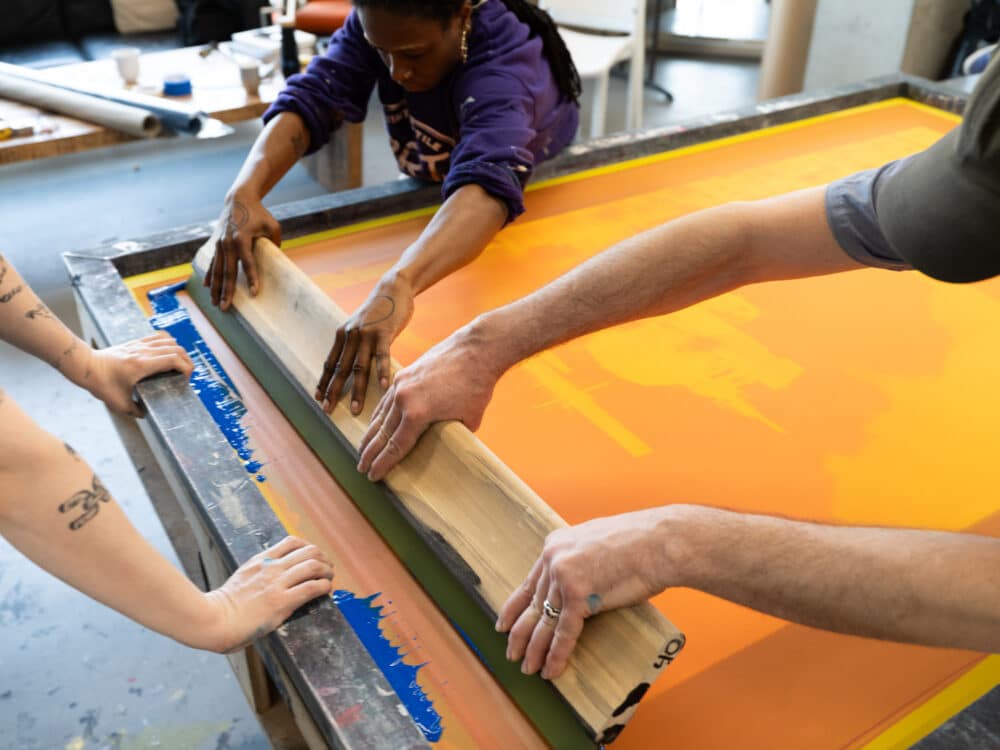The Necessary Guide to Understanding Screen Printing and Its Versatile Makes use of
Screen printing has a rich history that dates back to old times, progressing right into an innovative strategy made use of throughout different industries today. This guide discovers the intricacies of the screen printing process, detailing its applications in fashion, home, and marketing decoration - 10:9 Design near me. Comprehending these fundamentals can open up imaginative possibility for both creative and industrial jobs. The complying with areas will certainly disclose important ideas and methods to enhance one's screen printing ventures
The History of Screen Printing
Screen printing has origins that trace back centuries, its advancement reflects the technological and imaginative developments of different societies. Coming from in ancient China, the method was initially utilized for decorating fabrics and later infect Japan, where it ended up being essential to Ukiyo-e woodblock printing. The approach moved to Europe in the 18th century, where it gained appeal amongst artisans and commercial printers. The creation of picture emulsion in the 20th century reinvented screen printing, enabling more detailed designs and better effectiveness. Musicians like Andy Warhol further drove its appeal, using the tool to develop legendary works that mixed commercialism and art. By the late 20th century, screen printing had actually established itself as a functional technique, used in vogue, advertising, and art. Today, it remains to evolve, integrating digital modern technology and expanding its applications across different industries.
The Screen Printing Refine Explained
Screen printing transforms creative visions right into concrete designs via a series of specific actions. An image is created and after that moved onto a screen, usually made of great mesh textile extended over a framework. A light-sensitive solution is related to the screen, which is exposed to light, setting in locations not covered by the image. After washing out the unhardened solution, a stencil is formed.
Next, the screen is put over the substratum, whether it be textile, paper, or another material. Ink is after that pushed through the open areas of the pattern making use of a squeegee, transferring the design onto the substrate below. This process can be repeated for several shades, calling for different screens for every color. Lastly, the published product is cured using heat to guarantee the ink adheres appropriately, causing a long lasting, lively layout on-line.
Sorts Of Screen Printing Techniques

Additionally, specialty strategies, such as discharge screen printing, remove color from the textile to develop softer prints, while aluminum foil screen printing uses metallic aluminum foil to accomplish a glossy finish (10:9 Design Screen Printing Texas). Each strategy supplies distinctive attributes, accommodating various imaginative requirements and manufacturing scales, inevitably broadening the possibilities within the screen printing domain
Applications of Screen Printing in Various Industries

Furthermore, the signs and advertising and marketing sectors use screen printing for developing attractive displays and banners. This method allows for vibrant colors and intricate designs that catch focus. In electronic devices, screen printing is used for using conductive inks to circuit card, vital for component links. The home decoration industry embraces screen printing to generate unique designs on fabrics and wall art. Overall, screen printing works as a vital device across diverse fields, enhancing items with personalized and aesthetically appealing graphics.
Tips for Effective Screen Printing Projects
While taking on a screen printing project, mindful attention to information can considerably improve the last result. Picking top quality products is essential; this includes the screen, inks, and substratums. Utilizing suitable mesh matters can influence ink deposition and detail resolution. Prep work is just as essential; thorough cleaning of displays and correct direct exposure times assure crisp prints.
Next, exact registration is essential for multi-color prints. Utilizing positioning tools can assist achieve specific layering. Additionally, testing prints on scrap materials prior to production aids identify possible concerns without wasting resources.

Regularly Asked Questions
What Products Are Finest for Screen Printing on Fabric?
Cotton and polyester blends are excellent for screen printing on fabric because of their durability and ink absorption. Furthermore, specialized fabrics like silk or canvas can create unique structures and coatings, enhancing the total design quality.
Exactly how Do I Tidy and Maintain Screen Printing Tools?
To keep and clean screen printing tools, one should regularly wash screens with proper solvents, evaluate mops for wear, lubricate moving parts, and store all products in a dry, dust-free environment to extend their life expectancy.
What Are the Ecological Influences of Screen Printing?
Screen printing can have significant environmental effects, consisting of chemical waste from inks and solvents, water usage during cleansing processes, and energy consumption. Sustainable methods and environment-friendly products are vital for lessening these unfavorable impacts.
Can Screen Printing Be Done in the house Efficiently?
Screen printing can be effectively done at home with the right materials and techniques. Enthusiasts can develop top quality prints, though success relies on their ability degree, tools, and understanding of the process involved.
What Are the Costs Related To Beginning a Screen Printing Company?

Starting a screen printing business entails costs for equipment, products, and office. First expenditures normally vary from a few hundred to numerous thousand bucks, depending on the scale, top quality of equipment, and desired production capability.
Screen printing has a rich history that dates back to old times, progressing right into an innovative technique utilized throughout numerous sectors today. Another strategy, rotating screen printing, employs round screens, helping with continual printing on textile rolls, thereby enhancing effectiveness for large-scale productions. Furthermore, specialized techniques, such as discharge screen printing, eliminate color from the fabric to produce softer prints, while aluminum foil screen printing applies metal aluminum foil to accomplish a shiny surface. In the fashion industry, screen printing is commonly used to develop lively designs on apparel, making it possible for brands to showcase their unique designs. Cotton and polyester blends are ideal for screen printing on material due to their sturdiness and ink absorption.